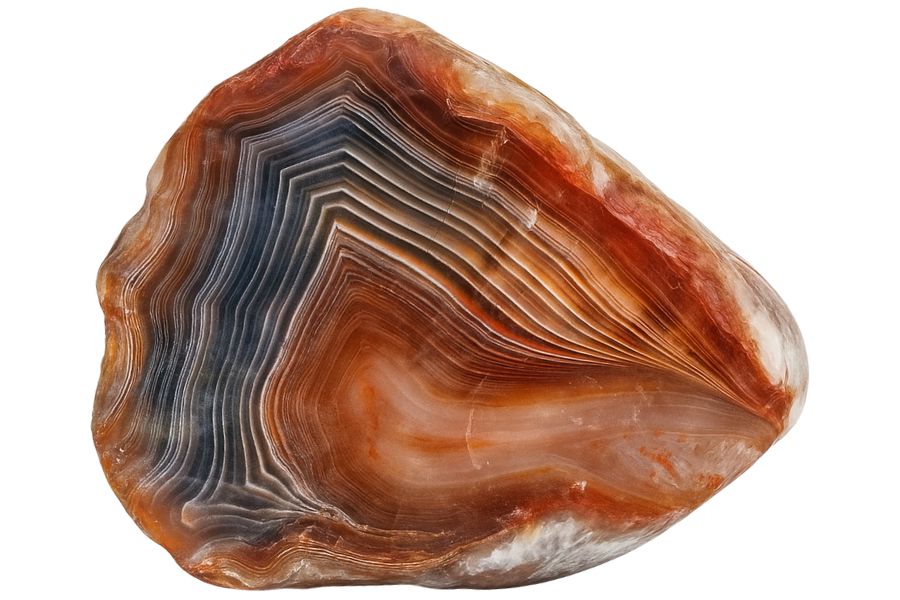Hunting for agates in Wisconsin opens up a world of natural beauty shaped by glaciers long ago. These stones lie hidden in the gravel and along waterways, waiting for sharp eyes to spot them.
Across Wisconsin, agates are scattered in places where water and ice once moved with incredible force. Over time, rivers, lakes, and exposed land carried and deposited them, leaving opportunities for today’s collectors.
Without knowing how to search, though, it is easy to overlook them among piles of ordinary stones.
The real excitement comes from learning how to recognize the subtle clues that set agates apart from other stones. With our guidance, you can return home with a collection that reflects the hidden treasures of Wisconsin’s land.
What is Wisconsin Agate?

Agate is a type of chalcedony that’s characterized by its banded appearance, with irregular patterns of different colors and opacity. It can display a wide range of hues, including earthy tones, vibrant reds, oranges, yellows, blues, and greens.
Deposits of this gemstone can be found in many countries, including Brazil, Uruguay, Mexico, India, Australia, and the United States. Within our country, among the notable agate-producing regions include Wisconsin. In fact, it’s our state’s unofficial State Gemstone.
Agate’s timeless allure and natural elegance make them highly sought after by gem enthusiasts and collectors worldwide. In fact, Agate’s price in the current market is a testament to its value.
Blue Lace Agate
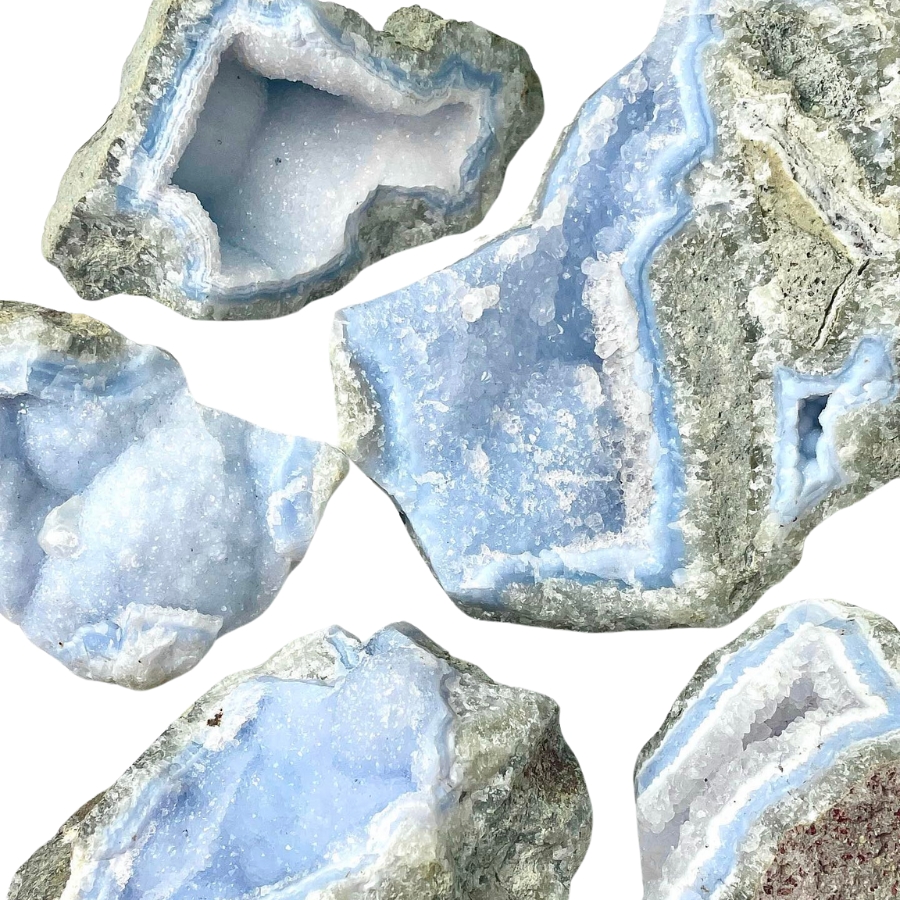
Blue lace agate is like the soft, sky-blue waves with lines that swirl and twist like delicate lace.
Its pattern comes from slow-forming layers of quartz, which create those beautiful, lace-like bands.
The bands of this agate type are often in shades of light blue, white, and sometimes a bit of grey. It’s different from other agates, which usually have more intense colors and stronger patterns.
The value of blue lace agate lies in its soft, tranquil look and the feeling of calm it brings. It’s often used in jewelry or as a decorative stone.
If you want REAL results finding incredible rocks and minerals you need one of these 👇👇👇
Finding the coolest rocks in isn’t luck, it's knowing what to look for. Thousands of your fellow rock hunters are already carrying Rock Chasing field guides. Maybe it's time you joined the community.
Lightweight, mud-proof, and packed with clear photos, it’s become the go-to tool for anyone interested discovering what’s hidden under our red dirt and what they've already found.
Join them, and make your next rockhounding trip actually pay off.
What makes it different:
- 📍 Find and identify 140 incredible crystals, rocks, gemstones, minerals, and geodes across the USA
- 🚙 Field-tested across America's rivers, ranchlands, mountains, and roadcuts
- 📘 Heavy duty laminated pages resist dust, sweat, and water
- 🧠 Zero fluff — just clear visuals and straight-to-the-point info
- ⭐ Rated 4.8★ by real collectors who actually use it in the field
Moss Agate
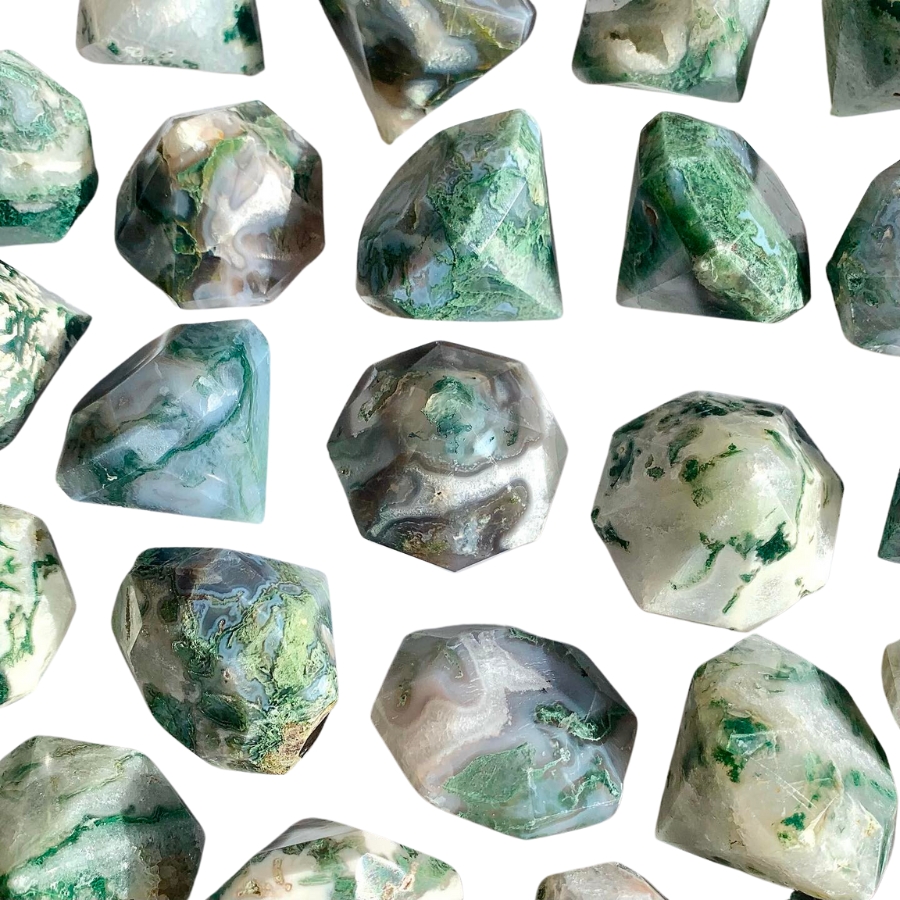
Instead of having the typical banding for which the different types of agates are known, moss agate has green inclusions that look like moss or trees.
These green patterns aren’t real plant material, though. They’re minerals like chlorite or iron oxide.
In some cultures, this type of agate is known as the “gardener’s stone” because of its green, plant-like appearance. It’s believed to help plants grow.
The price of moss agate can vary. It’s often quite affordable, but the more distinct and picturesque the green patterns, the more it might cost.
Fire Agate
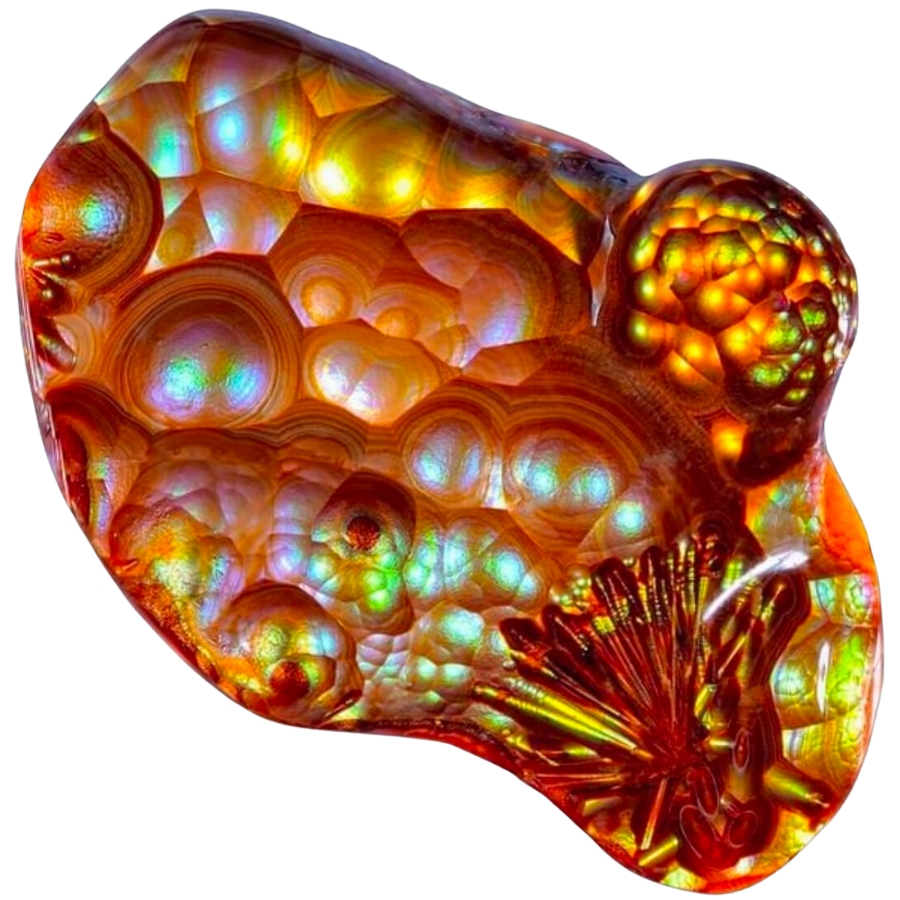
Fire agate is known for its incredible colors and the way it sparkles like fire. It’s got layers of silica and iron oxide that reflect light, creating a fiery effect.
When you look at fire agate, it’s like seeing flames trapped inside. Its colors can range from reds and oranges to greens and golds, all shimmering under the surface.
You might be wondering, “What is fire agate worth?” Well, its value comes from its rare beauty. The more color and sparkle, the more valuable the stone is.
Its fiery iridescence and lively play of color are used in jewelry pieces that are meant to stand out.
Dendritic Agate
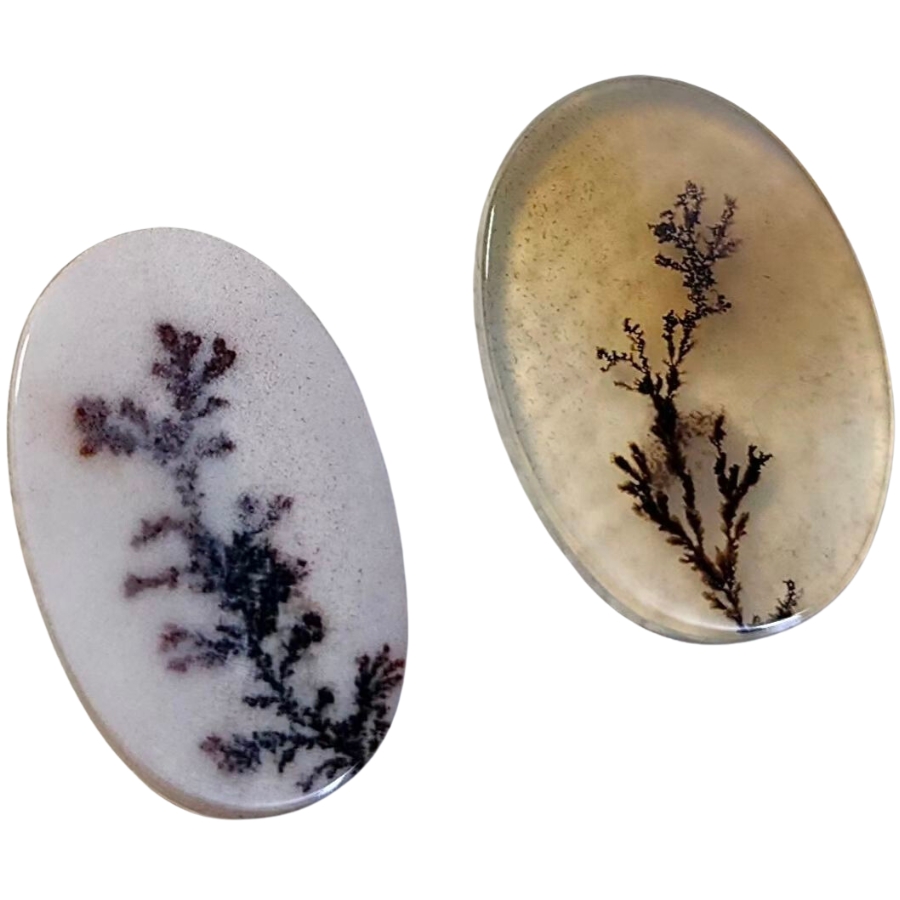
Dendritic agate is known for patterns that look like tiny trees or shrubs. Like moss agate, these patterns aren’t actual plants. They’re made of minerals, mostly manganese or iron oxides.
When you look at a dendritic agate, it’s like peering into a miniature forest or a frosty winter landscape.
The base of the stone is usually translucent to opaque, and the “dendrites”— those tree-like patterns— are often black or brown.
When it comes to how much dendritic agate is worth, it can vary. The more detailed and distinct the patterns are, the more it’s usually valued.
In some cultures, dendritic agate is believed to bring fullness and richness to life.
Crazy Lace Agate
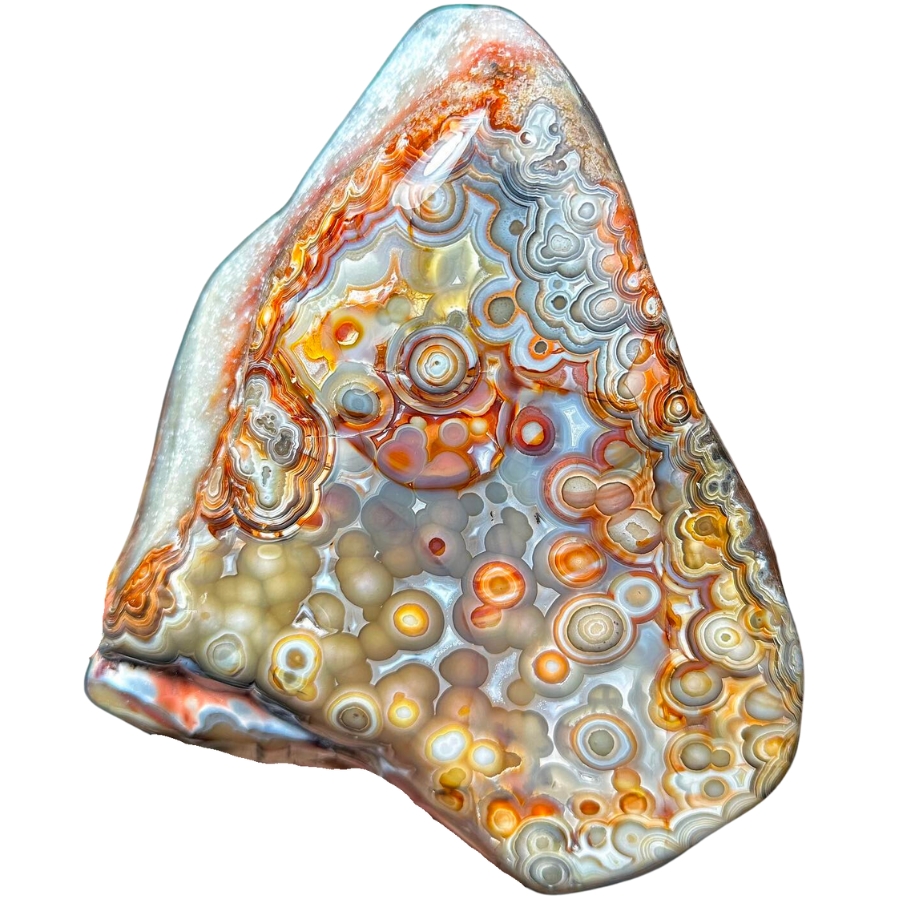
Crazy lace agate is like a party in a rock! It’s got swirls, circles, and all sorts of wild patterns dancing across it.
Its colors can be a mix of red, orange, yellow, and brown, and sometimes even a bit of gray or white.
What makes crazy lace agate stand out is its vibrant and complex patterns. No two pieces are the same. This distinctiveness is a big reason why it’s so valued.
Despite its wild and ‘crazy’ appearance, it’s sometimes called the “Laughter Stone” or “Happy Lace” because of the joy and positive vibes it’s believed to bring.
Laguna Agate

Laguna agate has incredibly sharp and fine banding. It has layers of red, orange, pink, yellow, and sometimes even purple and white all stacked in neat, tight bands.
These bands can form eye-catching patterns, like swirls, loops, and even landscapes.
The different colors of its bands come from various minerals present in the water at the time of its formation.
Laguna agate is considered one of the finest agates in the world due to its exceptional banding. This high regard among agate varieties makes it a prized possession for collectors.
Condor Agate

Condor agate is a real standout. It’s known for its bright, vivid colors and complex patterns.
It has reds, oranges, yellows, and sometimes even blues and greens all swirling together. These colors form in bands or in more random, artistic patterns.
The intensity and variety of its colors is what makes condor agate so special. It’s often used by artists and craftsmen who want to make a statement with their work.
Condor agate’s bold colors and patterns can turn a simple piece of jewelry or art into something really eye-catching.
Fortification Agate (Banded Agate)
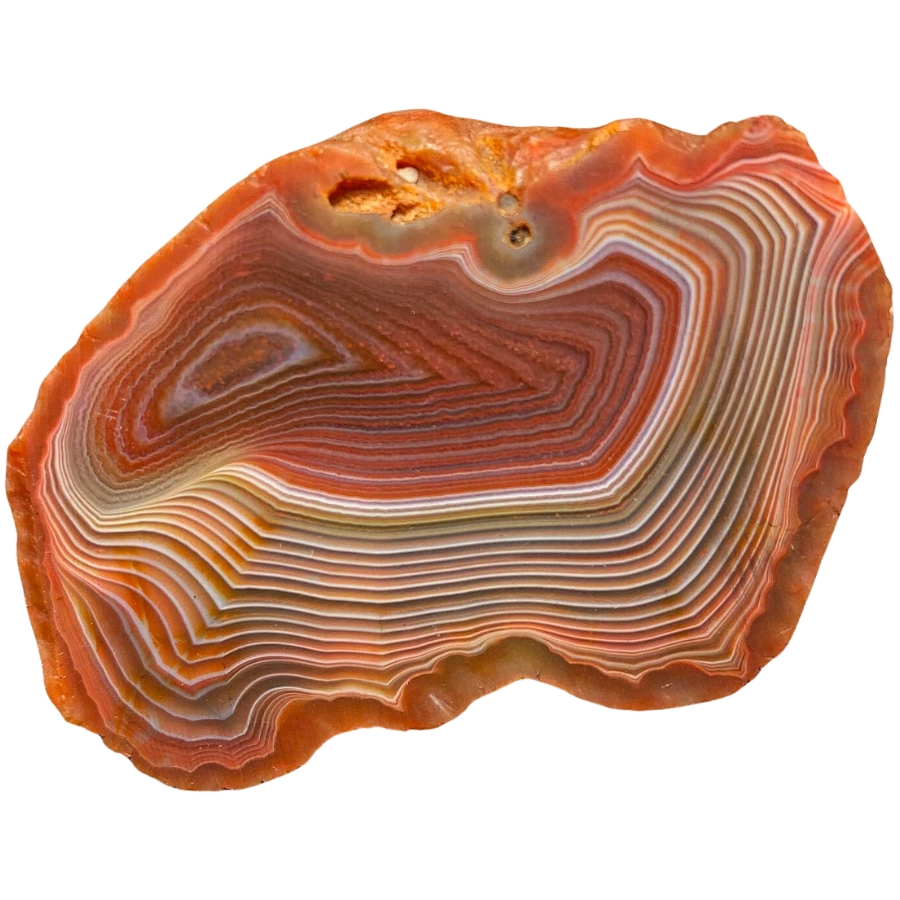
Fortification agate gets its name because the patterns inside it look like the aerial view of a fortified city.
Imagine seeing bands of color forming shapes that look like walls, with sharp angles and curves. They are usually in different colors, making each layer stand out.
If fortification agate is valuable, it’s because of its distinct patterns and colors. Its unique look makes it sought after for jewelry and as a collector’s item.
The clearer and more defined the patterns, the more valuable the stone can be. Some people also believe it can help with relaxation and calmness.
Iris Agate
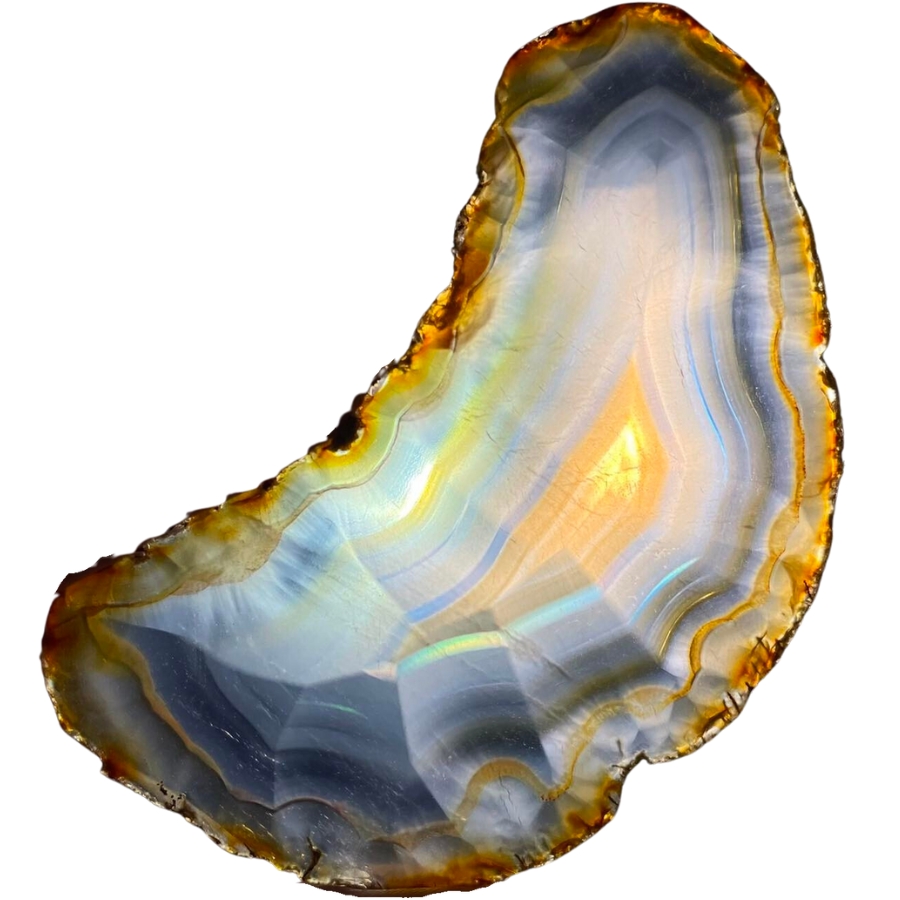
Iris agate looks like a regular agate at first, but when you hold it up to the light, something amazing happens. It shows all these rainbow colors, like light passing through a prism.
This is because it has very thin layers of silica, and when light hits these layers, it splits into all the colors of the rainbow.
The formation of iris agate is similar to other agates, but its layers are super thin, which is what creates the rainbow effect.
The value of iris agate comes from its unique ability to show these colors. In the past, people even used to think it had magical properties because of the way it showed colors. They saw it as a stone of good luck and wonder.
Plume Agate
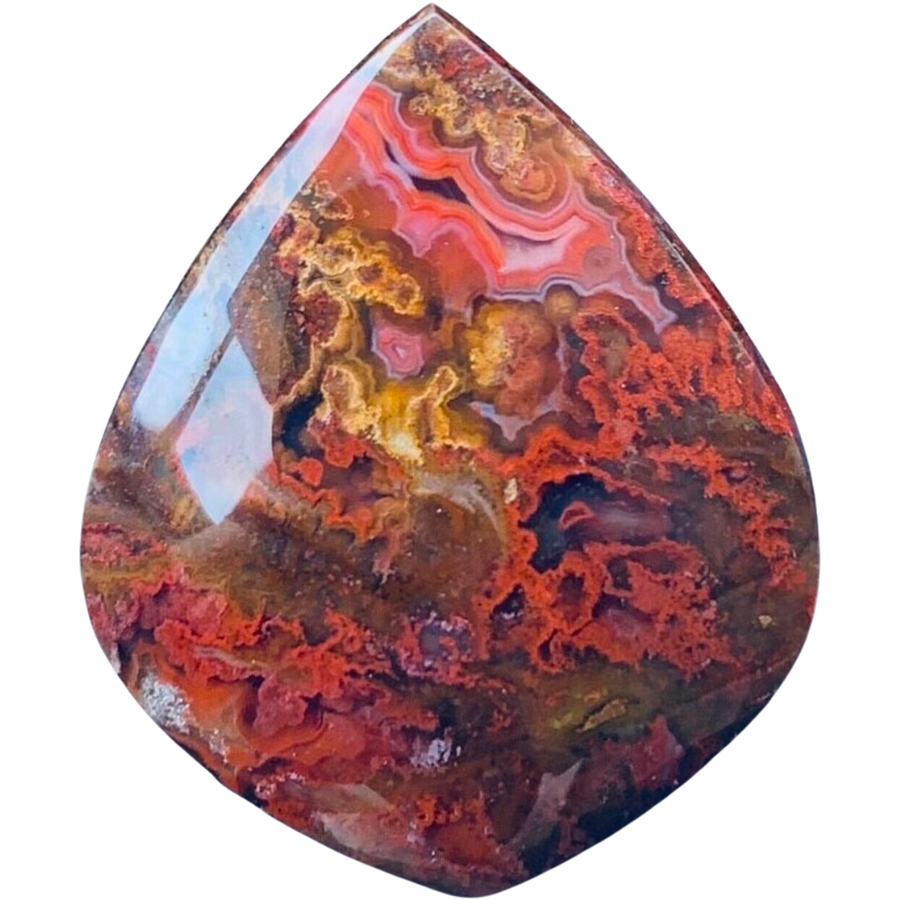
Plume agate gets its name from its patterns that look like soft, feathery plumes. These plumes can be in all sorts of colors: red, black, green, or yellow, set against a translucent or opaque background.
The way these plumes seem to float in the stone makes it look like a frozen underwater scene or like feathers caught in a breeze.
The plumes are made of minerals like manganese or iron oxide, which get trapped in the silica during the agate’s formation and create the feathery patterns.
The price of plume agate can vary depending on how clear and intricate the patterns are. The more detailed and colorful the plumes, the more the stone is usually worth.
Picture Agate (Scenic Agate)
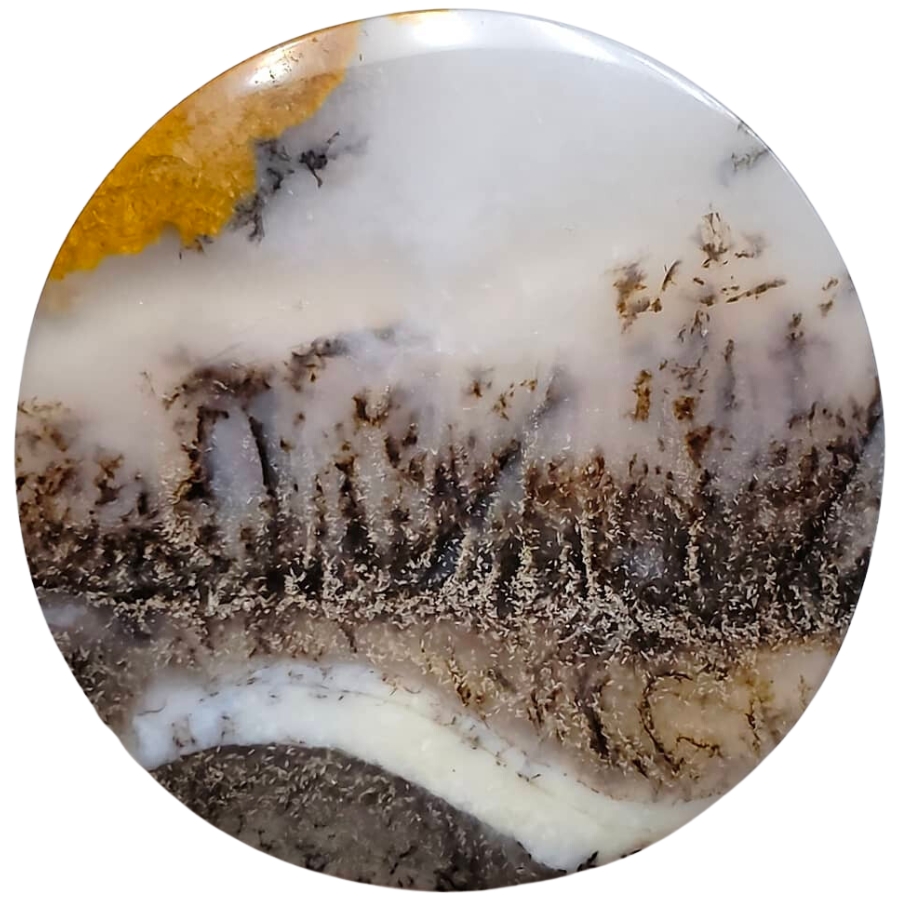
Picture agate is like a snapshot of nature captured in stone because it looks like it has pictures or scenes right inside it.
These “pictures” are actually natural patterns that resemble landscapes, mountains, trees, or even skies. They are usually in different shades of brown, white, and gray against a more translucent background.
The different patterns in picture agate or what’s also called scenic agate are made by various minerals in the water filled with silica that forms it.
If you’re thinking, “What is picture agate worth?“, its value comes from how distinct, clear, and detailed the natural “pictures” are.
Turritella Agate
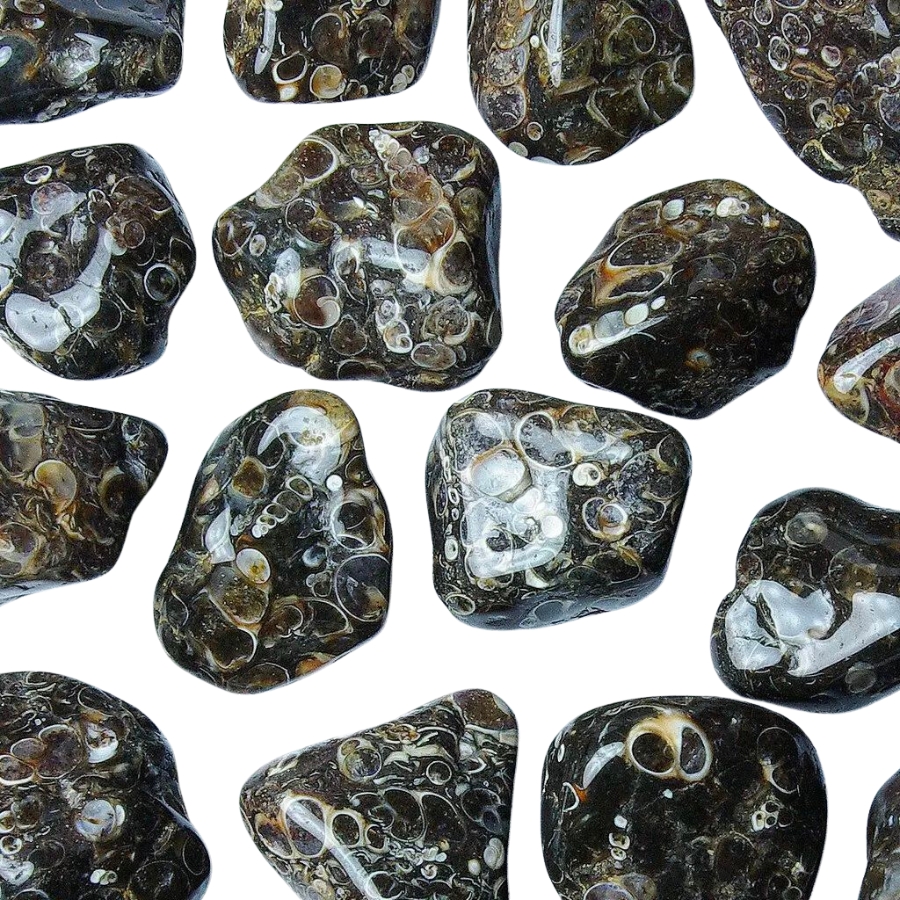
Turritella agate is not your typical agate because it’s full of fossilized snail shells! The shells belong to a creature called Turritella, a type of sea snail.
These shells are tightly packed and create a pattern that looks like a bunch of tiny, swirling towers. The background of the agate is usually a dark, earthy color, which makes the white or cream-colored snail shells really pop.
Over millions of years, these snail shells got buried in sediment and eventually became fossilized. As time went on, silica-rich water flowed through the sediment, turning it into the agate we see today.
The value of turritella agate comes from its unique blend of geology and history. More than a pretty stone, it’s a piece of ancient life preserved in rock.
Fairburn Agate
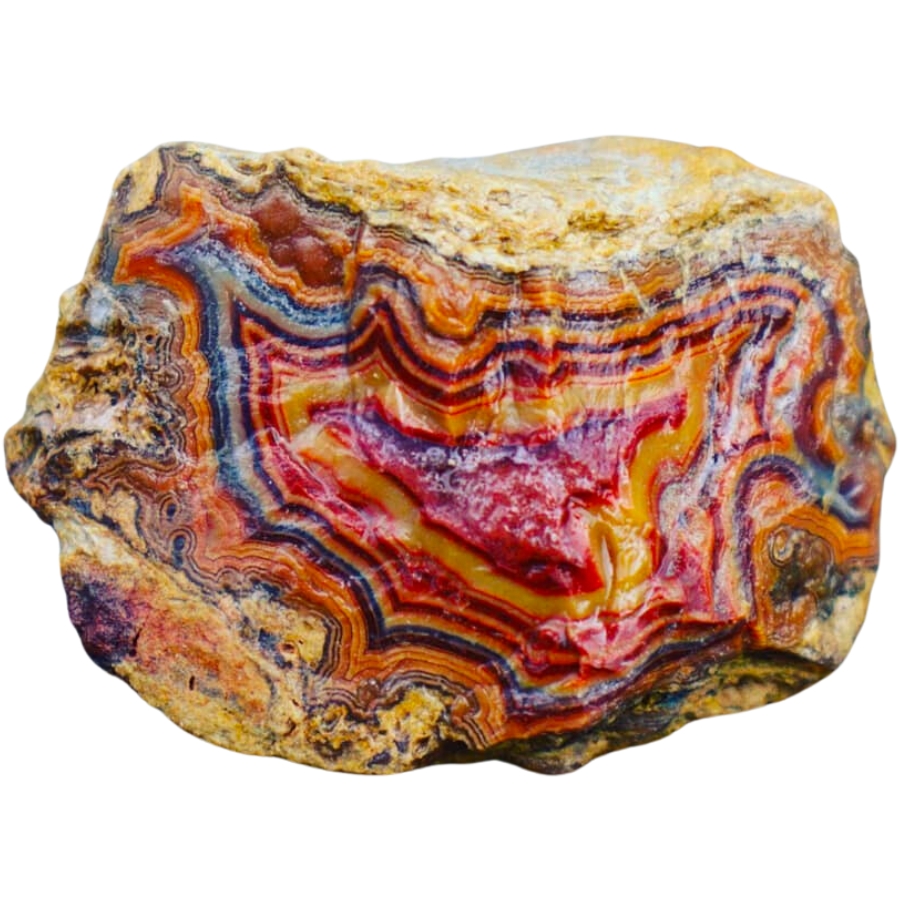
Known for its intricate patterns and bold colors, Fairburn agate is another fascinating type of agate. It usually has bands and swirls of different colors like red, yellow, orange, brown, and sometimes even pink or purple.
What’s special about these patterns is they often look like they’re in layers, creating a 3D effect. It’s like looking at a landscape made of stone.
It’s named after a place called Fairburn in South Dakota. This gives a clue about where it was first discovered.
People value Fairburn agate for the skill it takes to cut and polish it, which makes the patterns and colors really stand out.
Sagenite Agate
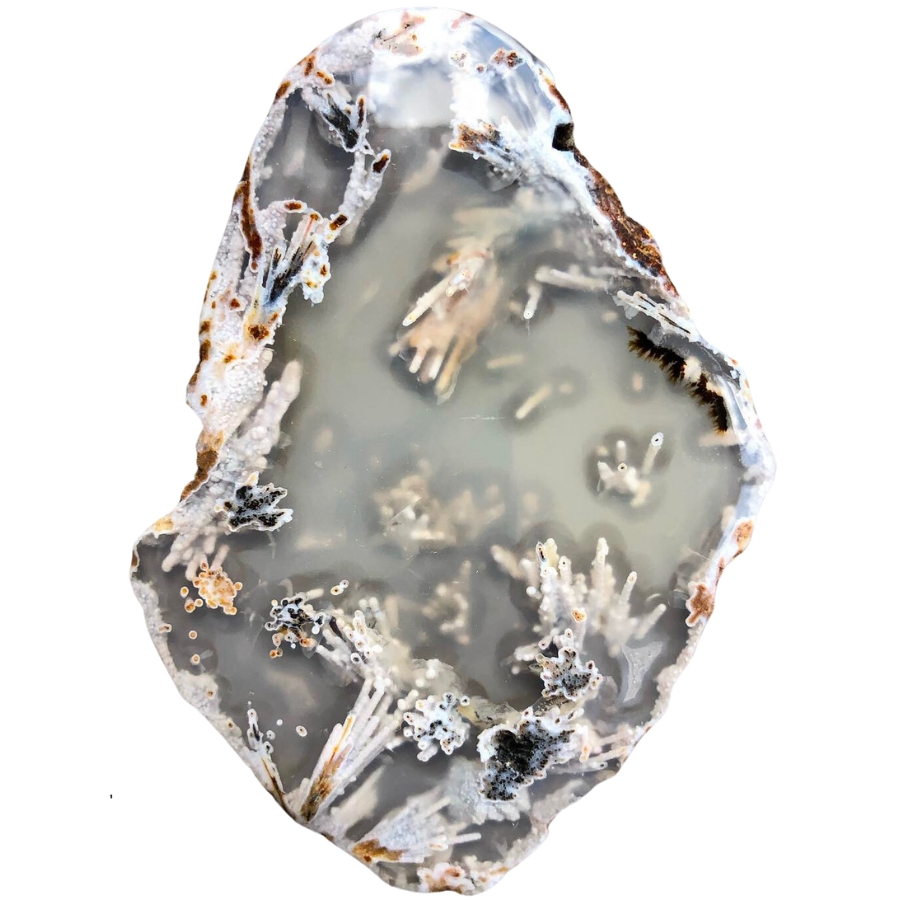
Sagenite agate has needle-like inclusions that look like tiny sprays of crystals inside it. They can be gold, silver, black, or even green, and they spread out in all directions, creating an amazing pattern.
The base of the agate is usually translucent, which lets you see these intricate needle patterns clearly.
These patterns are actually other minerals, like rutile or goethite, that get trapped inside the forming agate. These minerals grow in a crystal shape, looking like needles or hair.
Sagenite agate is often used in jewelry and other decorative items, with some people thinking that its needle patterns look like fireworks or starbursts.
Tree Agate

Tree agate, as its name suggests, looks like it’s got tiny trees or branches inside it. These tree-like patterns are usually green and spread out against a white or light gray background.
The green patterns aren’t actual trees, though. They’re made of minerals like chlorite or manganese.
Each piece of tree agate is different. You won’t find two that are exactly the same. It’s valued for its looks and it’s often used in jewelry and decorations.
The key factors in our recommendations are:
- The deep experience and understanding of our team about the area
- Recommendations from local groups and clubs
- How easy it is to get the a particular location
- Safety and potential hazards when collecting
- Weighing private and public locations
- The ability for both experienced and novice agate enthusiasts to find great samples
With these factors in mind we’ve been able to put together a fantastic list that just about anyone can use!
Kids. Beginners. Pros. Doesn’t matter. This book has become the go-to because it works for everyone.
Magy put it bluntly: “Identify rocks, crystals and minerals is so easy now!”
That’s not by accident, the photos are crisp, the callouts are simple, and the design is rugged enough to throw in a backpack without worrying. Whether it’s your first geode or your hundredth, this guide keeps the fun part simple: finding more treasures.
The Best Spots To Find Agates in Wisconsin
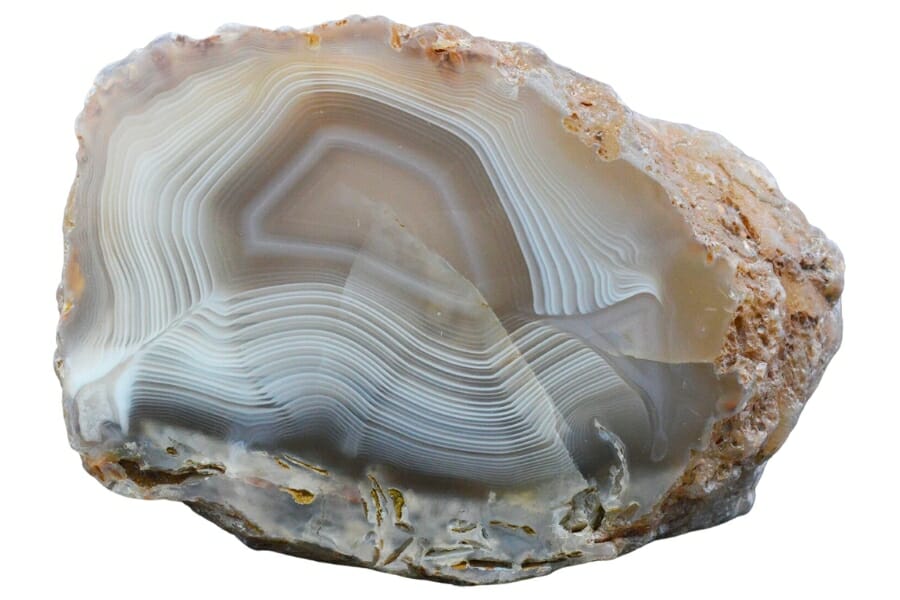
Our state is incredibly blessed with natural wonders, so much so that we have plenty of gem mine sites in Wisconsin. However, if you want to narrow down your search to only Agates, below are our most highly-recommended spots:
Always Confirm Access and Collection Rules!
Before heading out to any of the locations on our list you need to confirm access requirements and collection rules for both public and private locations directly with the location. We haven’t personally verified every location and the access requirements and collection rules often change without notice.
Many of the locations we mention will not allow collecting but are still great places for those who love to find beautiful rocks and minerals in the wild without keeping them. We also can’t guarantee you will find anything in these locations since they are constantly changing.
Always get updated information directly from the source ahead of time to ensure responsible rockhounding. If you want even more current options it’s always a good idea to contact local rock and mineral clubs and groups
Black River
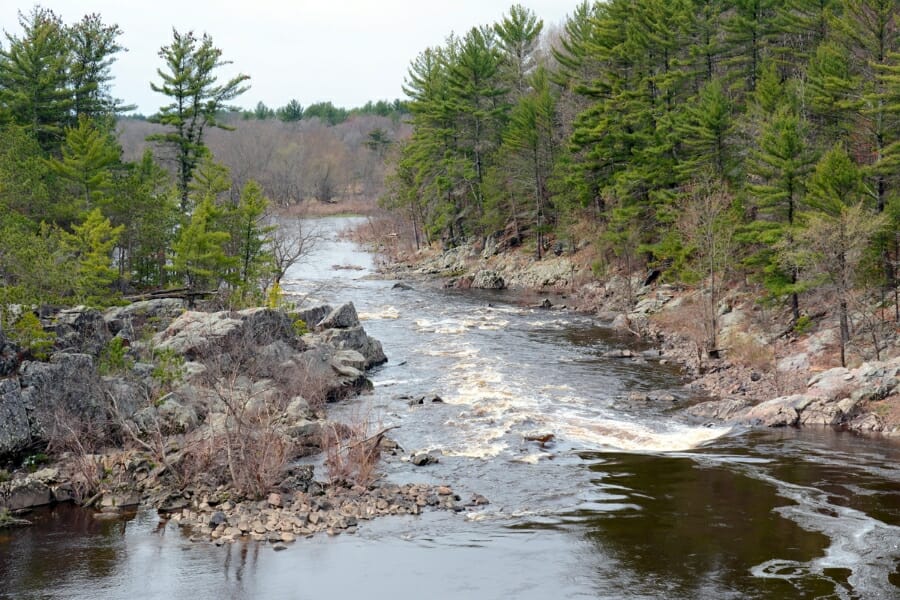
Black River holds both adventure and treasure for those willing to explore its waters. The river winds its way through the western part of our state, meandering through forests, valleys, and picturesque landscapes.
As you venture along this river’s course, you’ll encounter stretches of calm waters as well as exciting rapids. Lush forests, rocky outcrops, and sandy shores surround the river, offering a variety of landscapes to explore.
Black River cuts through layers of sedimentary rock, exposing ancient formations and revealing hidden treasures. You can find stunning samples of Agate here and in its tributaries.
Getting here is relatively easy, too, as it’s accessible by road with various entry points along its course. Just make sure you familiarize yourself with Wisconsin’s latest collecting guidelines before beginning your expedition here.
Where we found agates in the Black River
You can comb and sift through the gravels of Black River and its tributaries to uncover stunning Agates with their intricate patterns and vibrant colors.
Chippewa Falls

Chippewa Falls is a vibrant and charming city situated along the banks of the Chippewa River. The river meanders through the city, offering breathtaking views and abundant recreational opportunities. Rolling hills, lush forests, and the river’s gentle flow make this city as picturesque as can be.
Whether it’s hiking along scenic trails, biking through the countryside, or kayaking on the river, there’s something for everyone at Chippewa Falls. The city has been known to yield beautiful Lake Superior Agates.
Reaching Chippewa Falls is a breeze, as it’s conveniently located near major highways.
Where we found agates in the Chippewa Falls
We recommend exploring the area gravel pits of Chippewa Falls to find stunning samples of Lake Superior Agates.
Ounce River
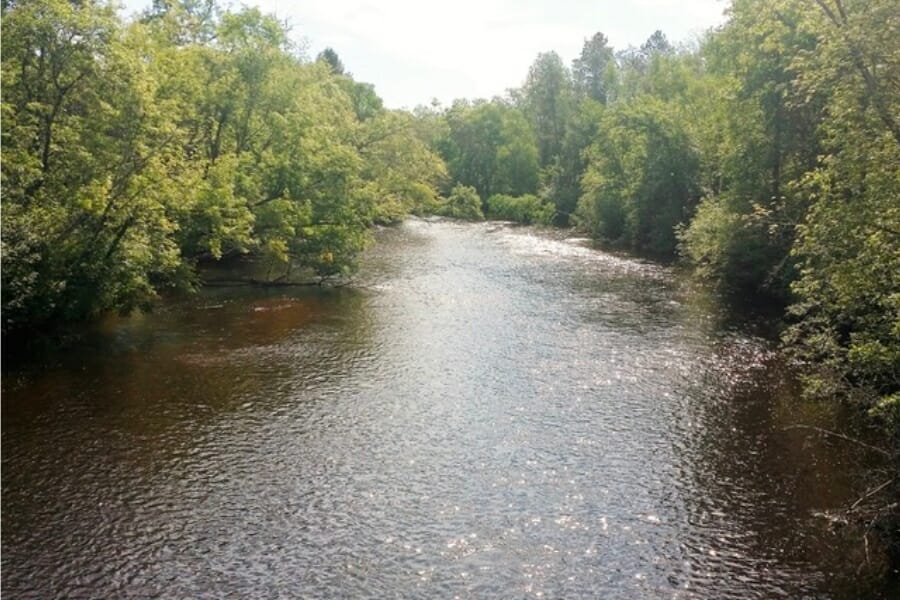
The picturesque Ounce River winds its way through a scenic landscape. Its rolling hills, dense forests, and rocky outcrops create a breathtaking backdrop as the river gracefully meanders through the terrain.
Along the Ounce River, you can find a mix of tranquil stretches and exciting rapids. It’s a playground for outdoor enthusiasts, with hiking trails that allow you to immerse yourself in the beauty of the surrounding nature.
The river flows through areas rich in sedimentary rock, creating ideal conditions for Agate formation, so this is a great place to find these gemstones. What’s more is that there are well-maintained roads that provide access to this area, so getting to Ounce River is pretty easy.
Where we found agates in the Ounce River
Scour through the banks of Ounce River to find samples of Agates, especially brown-colored ones.
Lake Pepin Beaches
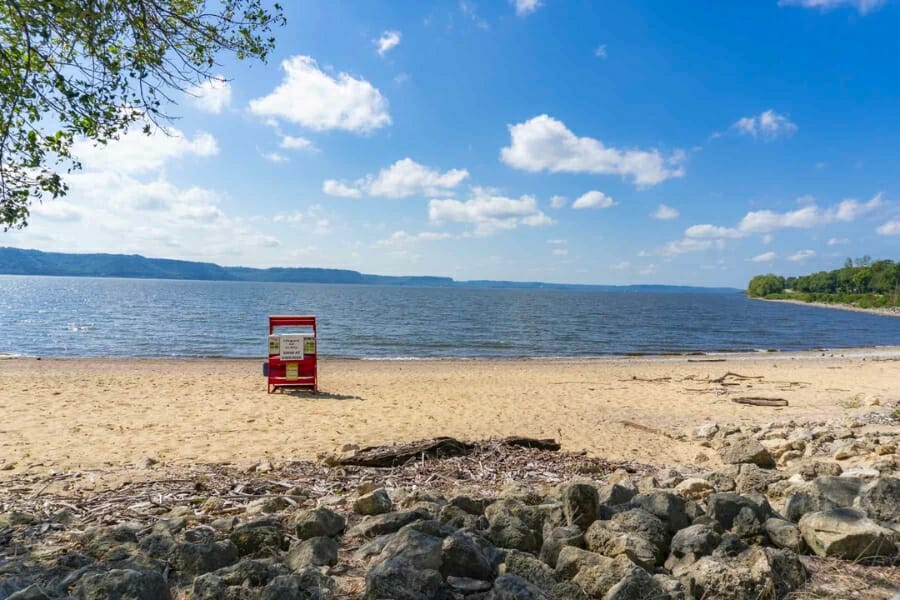
The stunning beaches of Lake Pepin are more than just a sight to behold— they’re also great places to find Agates. Lake Pepin itself, a picturesque widening of the Mississippi River, boasts of pristine sandy shores, crystal-clear waters, and breathtaking views.
When you go here, you’ll see rolling hills, lush forests, and the expansive lake that stretches as far as the eye can see. The area also has a mix of sandy stretches, rocky outcrops, and peaceful coves.
Lake Pepin’s geological history has also contributed to the formation of Agates along its shores. If you want to go here to find them, you can easily do so since this area has several access points and parking areas.
Where we found agates in the Lake Pepin Beaches
You can spend some time beachcombing through Lake Pepin’s beaches to find amazing specimens of Agate.
Devil’s Lake State Park
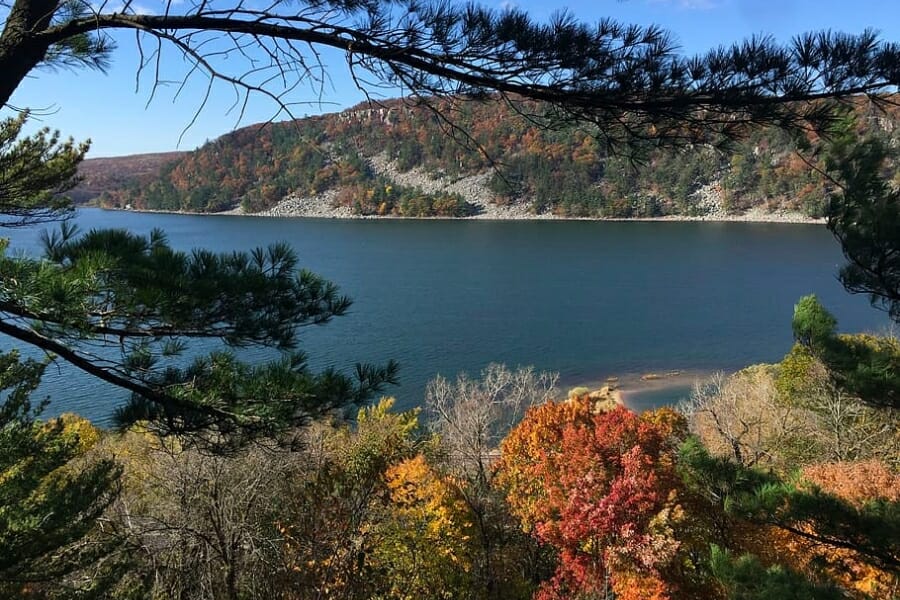
Nestled amidst picturesque landscapes, the Devil’s Lake State Park is surrounded with stunning bluffs and cliffs, creating a breathtaking backdrop. The park has a diverse terrain, with rocky outcrops, lush forests, and serene meadows.
Hiking trails wind their way through the park, leading to magnificent viewpoints. Rock climbing enthusiasts are also drawn to its impressive bluffs, which provide challenging routes and exhilarating climbs. The park is also popular for water activities in the clear waters of Devil’s Lake.
But a fascinating aspect of Devil’s Lake State Park is its naturally-occurring Agates. These natural treasures add an element of excitement and wonder to the experience of exploring here. The park also offers well-maintained roads, ample parking areas, and clear signage, making it easily accessible for visitors.
Where we found agates in the Devil’s Lake State Park
You can explore the expansive Quartz deposit in Devil’s Lake State Park to find Lake Superior Agates.
Other Great Places To Find Agates in Wisconsin
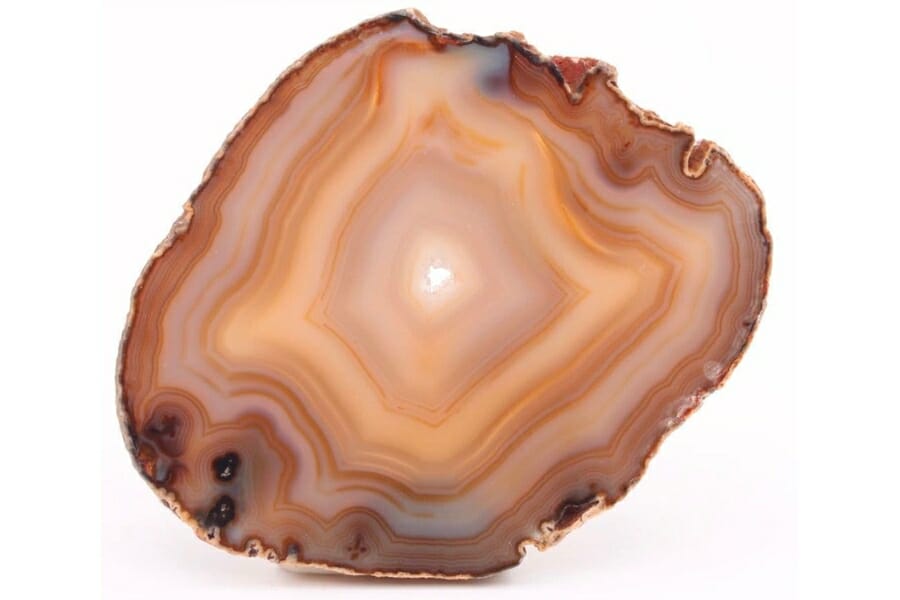
If you’ve already exhausted our initial recommended sites, fret not, because there are plenty other Agate-bearing spots in Wisconsin that you can visit. We’ve listed them by county below to make it easier for you to use this guide.
Our recommendations by county
| County | Location |
| Ashland | Regional streams and gravels |
| Bayfield | Stream gravels, pits, and excavations |
| Clark | Neillsville regional stream gravels |
| Crawford | Prairie Du Chien area quarries, stream gravels, excavations |
| Crawford | Prairie City Gravel Company |
| Crawford | Dillman Gravel Company |
| Douglas | Abandoned Weyerhauser Copper mines and dumps |
| Dunn | Menomonie area gravel pits and quarries |
| Grant | Cassville regional gravel deposits, quarries, stream beds |
| Grant | H. Turner & Son Gravel Company |
| Grant | Muscoda area quarries, stream gravels, pits |
| Iron | Regional stream gravels, gravel pits, excavations |
| La Crosse | Area quarries, gravel pits, stream gravels |
| La Crosse | Bluffs of the Mississippi River along entire west boundary of the state |
| Pepin | Durand area quarries and gravel pits |
| Pepin | Deer Island |
| Pierce | Rush River Gravel Company |
| Pierce | Weiser Sand and Gravel Company |
| Pierce | River Falls Sand & Gravel Company |
| Sauk | Baraboo area quarries and gravel pits, especially in the Baraboo Range |
| Sawyer | Ojibwa regional stream gravels |
| Sheboygan | Bluhm Gravel Pit |
| St. Croix | Broad area of Hudson to northeast to New Richmond |
| Washburn | Roadside fill gravels, road cuts, and area gravel pits of Spooner |
| Wood | Central part in stream gravels |
| Wood | Regional mine dumps |
Additional areas you can find agates
Pay extra attention to the following areas where Agate can usually be found. This is especially helpful is you’re exploring places that cover wide perimeters.
Streams and Creeks
Streams and creeks offer a great opportunity to uncover Agates that have been polished by the water’s movement over time. The water acts as a natural sorter, allowing Agates to settle in specific areas, such as gravel bars or along the riverbed. With a keen eye, you can spot them gleaming amidst the rocks and pebbles.
Lake Shores
Wisconsin’s lake shores, particularly those along Lake Superior and Lake Michigan, are renowned for their abundance of Agates. These vast bodies of water have played a crucial role in shaping and depositing these gems along their shores over countless years.
Quarries
Quarries in Wisconsin are also some of the best spots to find Agates that have been preserved in their natural state, often untouched by the forces of erosion. The mining activities that take place in these quarries expose layers of sedimentary rock, where Agates are commonly found.
Common Agate-Hunting Questions
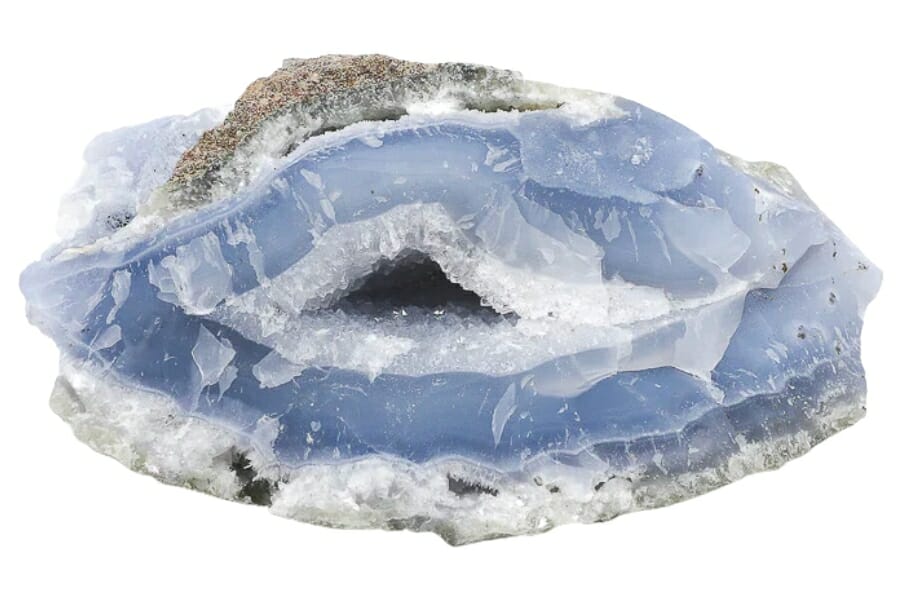
We’ll answer some of the most common questions when it comes to Agate hunting in case you have the same queries in mind.
Is it illegal to collect agate in Wisconsin?
You may collect Agate in Wisconsin for as long as you ensure that you are following our state’s local collecting guidelines. For example, collecting in state parks is strictly forbidden. You should also secure necessary permit or permission before starting any form of exploration.
The Best Places To Buy Agates In Wisconsin
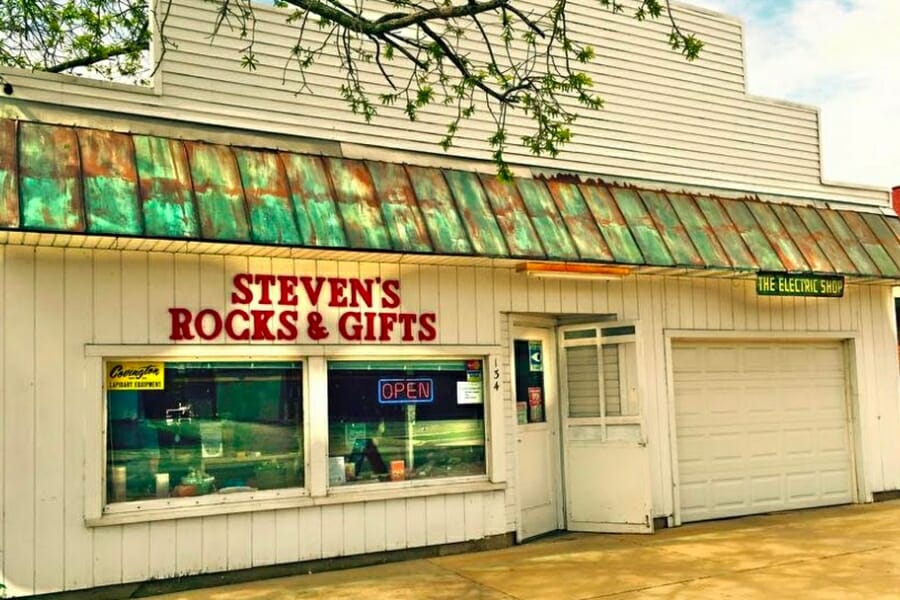
If you prefer a more relaxed way to marvel at Agates, with the potential of purchasing them, you’re welcome to visit our local gem shops that offer great selections. Below are some of the best ones that we have:
- Gary’s Rock Shop – 317 S Main St, Viroqua, WI 54665
- Mystical Earth Gallery – 220 Main St, Menasha, WI 54952
- Roxy’s Rock Shop – 2218 S Ridge Rd, Green Bay, WI 54304
- Steven’s Rocks & Gifts – 134 E Main St, Marshall, WI 53559
- The Gem Shop, Inc. – W64N723 Washington Ave, Cedarburg, WI 53012
If you have any recommendations for our list please leave a comment below!

